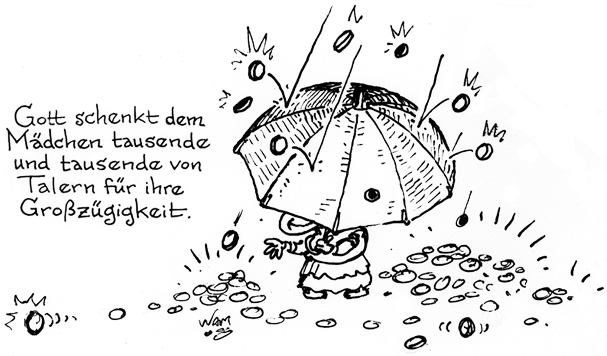Der Dativ – The Dative Case
The dative case is used to describe the indirect object of a sentence. The indirect object is the recipient of the direct object. In addition to changes in the article, plural nouns also receive an –n suffix (except for nouns that already end in an –n).
| Das Mädchen gibt dem Mann sein Stückchen Brot. | The girl gives the man her* piece of bread. |
| Es gibt den Kindern seine Mütze, seinen Rock und sein Hemd. | She gives the children her hat, her skirt and her shirt. |
| Gott schenkt dem Mädchen Taler für ihre Großzügigkeit. | God gives the girl coins for her generosity. |
* Nota Bene: although in English ‘girl’ is referred to as ‘she,’ in German the word ‘Mädchen’ is grammatically neutral, so the possessive pronoun has to be ‘sein’ (its). Right now, there are more and more people who would refer to Mädchen as ‘sie’ (she, her), especially among young people, since they find it insulting to talk about females as ‘it.’
Nevertheless, in formal writing, if the pronoun appears in the same sentence as the word ‘Mädchen,’ it should be neuter (‘es’ ‘sein’, usu.). However, please note that the native speaker narrator used ‘ihre Großzügigkeit’ in the last sentence instead of ‘seine ‘…
![]() Definite and Indefinite articles in the dative case
Definite and Indefinite articles in the dative case
Articles in the accusative case (there is no equivalent of the indefinite article in the plural, since, just like in English, you can’t say ‘a lentils’):
| the | a/an | none | ||
| masculine | dem Mann | einem Mann | keinem Mann | (man) |
| feminine | der Frau | einer Frau | keiner Frau | (woman) |
| neuter | dem Kind | einem Kind | keinem Kind | (child) |
| plural | den Kleidern | Kleidern | keinen Kleidern | (clothes) |
Please note that plural nouns also get an –n suffix, unless there is an -s ending.
| Need –n | |||
| die Kinder | => | den Kindern | (children) |
| die Männer | => | den Männern | (men) |
| die Taler | => | den Talern | (old coins) |
| die Sterne | => | den Sternen | (stars) |
| Don’t need –n | |||
| die Eltern | => | den Eltern | (parents) |
| die Mädchen | => | den Mädchen | (girls) |
| die Frauen | => | den Frauen | (women) |
| die Prinzen | => | den Prinzen | (princes) |
Word order
When a sentence or clause contains both a dative and an accusative noun, the dative noun precedes the accusative noun:
| Das Mädchen gibt dem Mann sein Stück Brot. | The girl gives her piece of bread to the man. |
| Es gibt den Kindern seine Kleider. | She gives her clothes to the children. |


